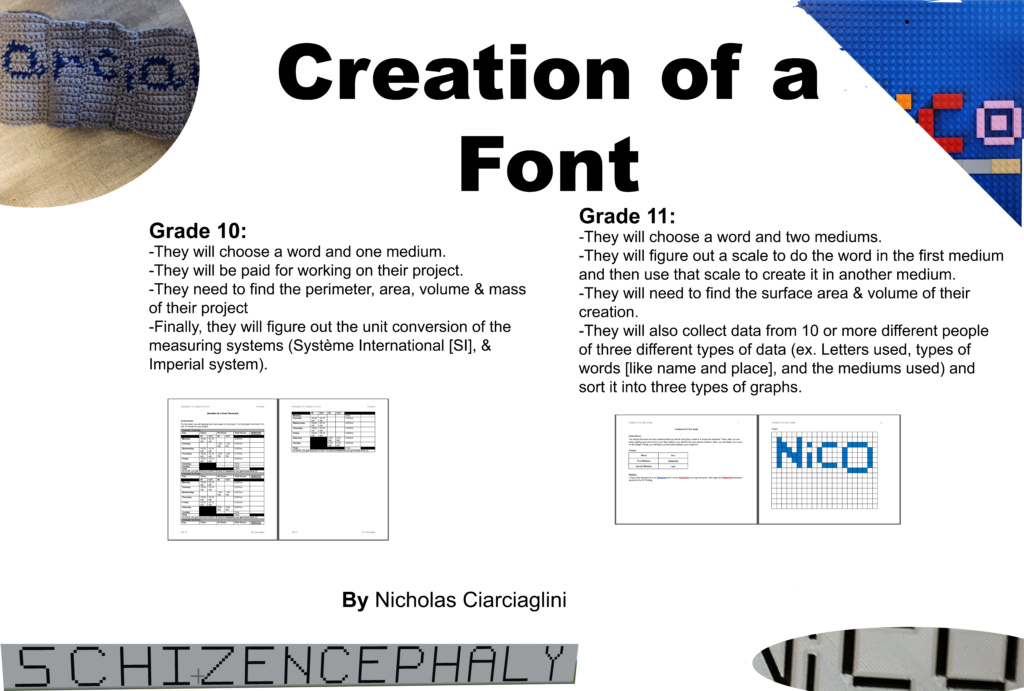
Makerfaire Presentation
Introduction:
In grade 10, they will create a word in their own style. They will be finding the Perimeter, Area, Volume, & Mass of their word. Then, they will convert the Perimeter, Area, Volume, & Mass into the other measuring system. They will log all their hours then they will figure out how much they will made in creating their project.
In grade 11, they will create a word in their own style. They will collect data from others and create different graphs. Then, they will calculate the Surface Area, and Volume of their project. Finally, they will figure out the scale between their two mediums.
My Process:
When I started this process I just wanted to create a name, instead of other words that have a personal connection (hobby, place, etc.). I told my mom what I was going to do but then my mom told me that “what if someone has a two letter name like ‘Al'”. Then, I realized that I need to do some-thing else. That is why I chose to do a personal word, it allows them the freedom to create this as how they want to design it.
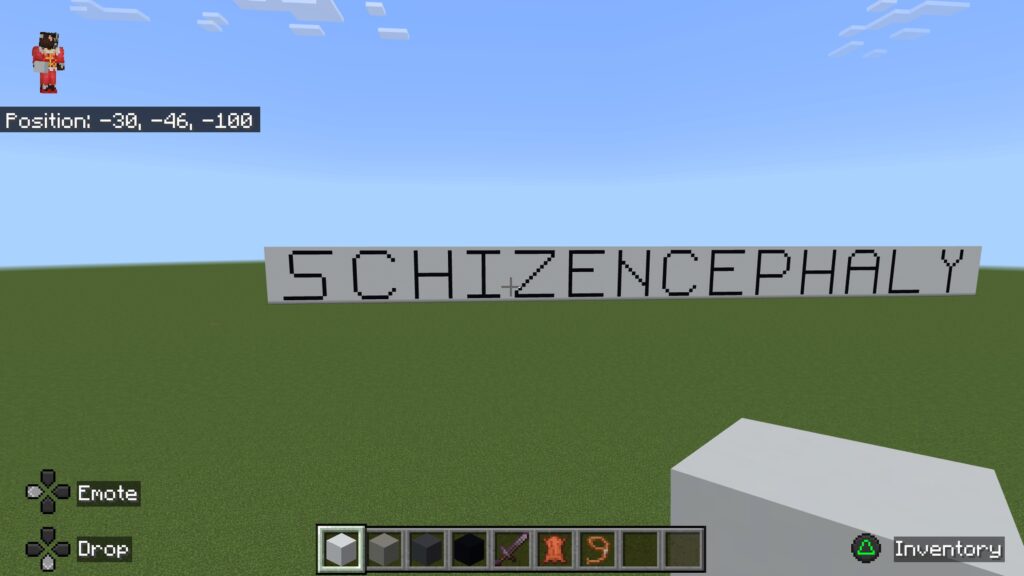
Take “Schizencephaly” for an example, I chose this word because I wanted to create something in Mincraft for this project and it was easy to create. There was no “Math” behind this word, but I wanted to do this.
In my own experience as a student, I watched others not wanting to do certain projects, because they have no interest, or think that this project is not engaging the student’s personality. This project will be used as an invitation to learn about the content in the curriculum, and at the same time as a place to imagine what they came up with. This is also going to be used for getting to know the students better and help them, and gain confidence to share what they come up with.
Learning Outcomes:
Workplace and Aprentiship 10:
- WA10.1:
- Demonstrate understanding of the preservation of equality including solving problems that involve the manipulation and application of formulas related to:
- perimeter
- area
- the Pythagorean Theorem
- primary trigonometric ratios
- income.
- Demonstrate understanding of the preservation of equality including solving problems that involve the manipulation and application of formulas related to:
- WA10.3:
- Demonstrate using concrete, and pictorial models, and symbolic representations, understanding of measurement systems including:
- The Système International (SI)
- The British Imperial system
- The US customary system.
- Demonstrate using concrete, and pictorial models, and symbolic representations, understanding of measurement systems including:
- WA10.11
- Demonstrate understanding of income including:
- wages
- salary
- contracts
- commissions
- piecework
- self-employment
- gross pay
- net pay.
- Demonstrate understanding of income including:
Workplace and Aprentiship 20:
- WA20.3
- Extend and apply understanding of surface area, volume, and capacity using concrete and pictorial models and symbolic representations (SI or imperial units of measurement).
- WA20.5
- Extend and apply understanding of 3-D objects including:
- component parts
- scale diagrams.
- Extend and apply understanding of 3-D objects including:
- WA20.11
- Extend and apply understanding of representing data using graphs including:
- bar graphs
- histograms
- line graphs
- circle graphs.
- Extend and apply understanding of representing data using graphs including:
Research:
- When I started this project, I wanted to create something difficult but not so difficult for students with disabilities.
- I also wanted to make something easy for me to do attendance every day and allow them to switch seats to get to know everyone.
- Then I found something called a Math Craft, which states “Crafts, Mathematics and Science, we understand that the curricula of these subjects share common goals, and thus wanted to provide the students interdisciplinary real-life learning context in these studies. Looking at the examples of STEM and PBL teaching in other countries” (Kokko et al., 2015).
Examples
WA 10:
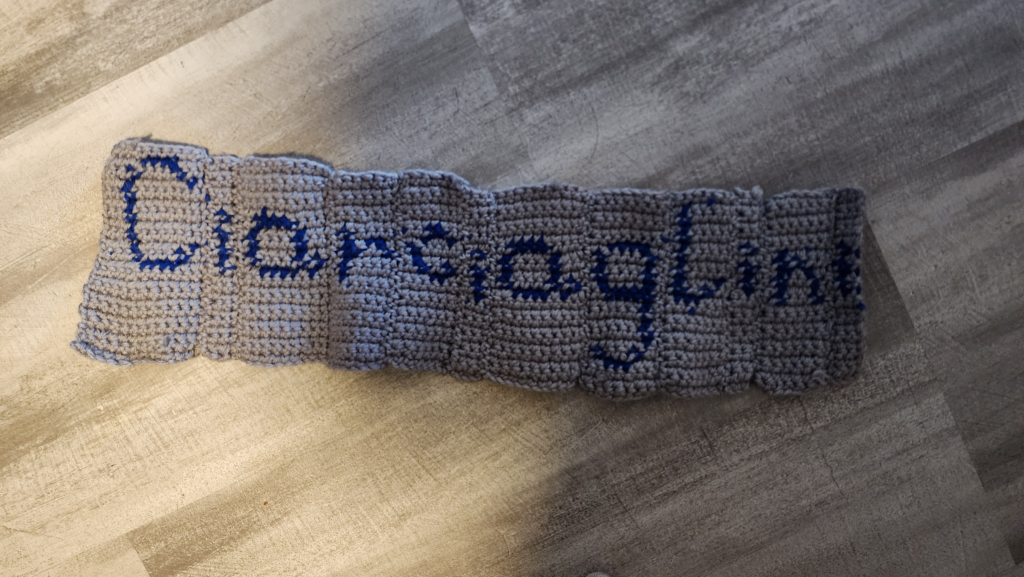
Worksheets
Worksheet 1
Worksheet 2
Worksheet 3 & 4
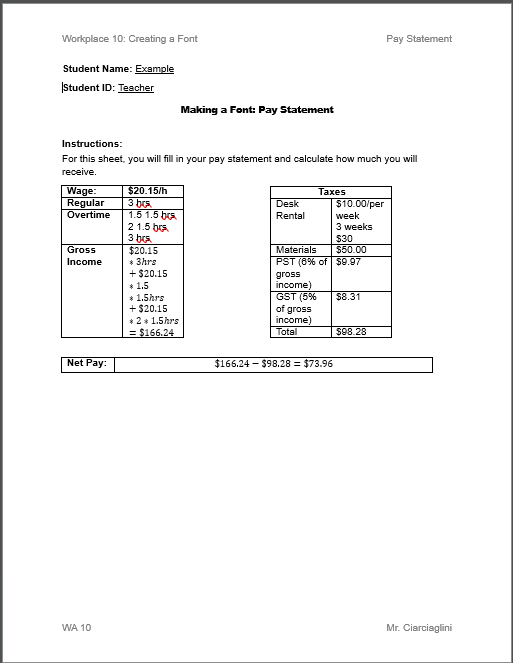
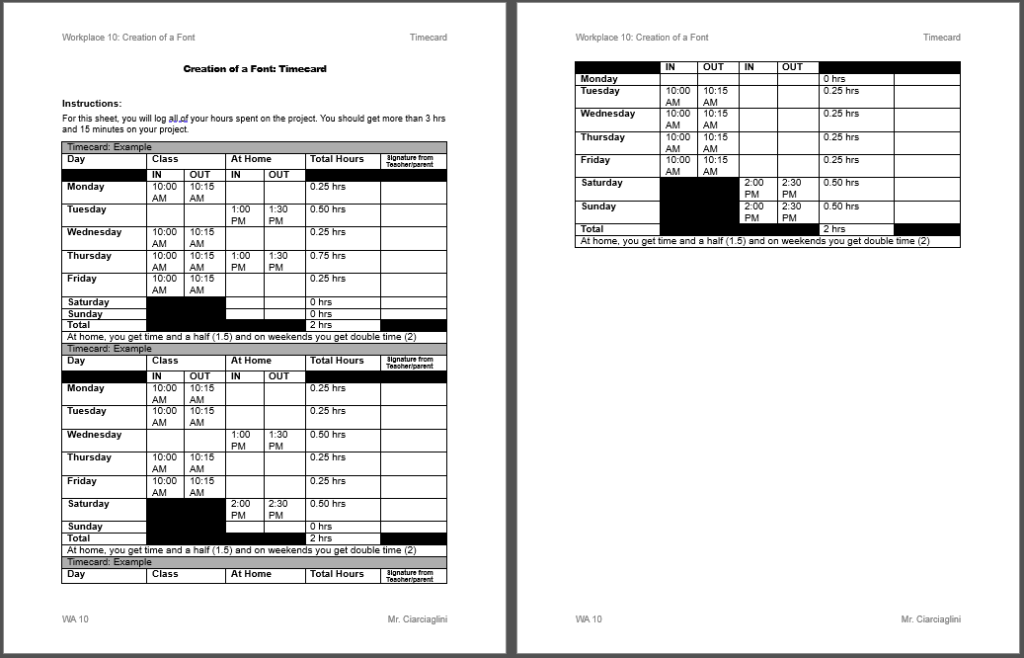
Reflection
I started this project with my crocheting medium, so I was taking time with this part of my project. Then I related it back to the content I learned about in Workplace 10. I related project to three units found in the textbook: Unit 2: Earning an Income, Unit 3: Length, Area, & Volume, and Unit 4: Mass, Temperature & Volume. In Unit 2, I decided to make it so that they have a imaginary job where they create something and they could have an income. Then in Unit 3 and 4, I made related it to math concepts that they learn about, they learn about perimetre, area, and volume of objects, also the mass of different objects as well. So, this was my first example for the Creation of a Font, I found it a bit difficult with making letters in a flat meduim but I found it to be fun to relate it back to mathematics.
I also did an example for “schizencephaly”, I created the example but never related it back to Math. I found it a bit hard to find the mass of the object but I am going to be making a chart of mass to help the students if they choose to create it in Minecraft (here). But overall it was fun creating it in the program.
WA 20:
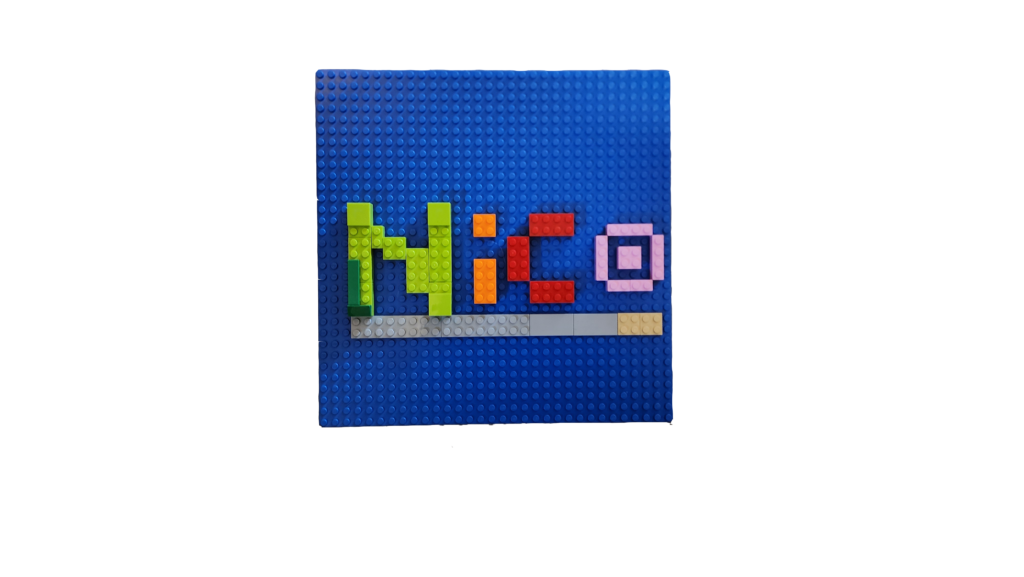
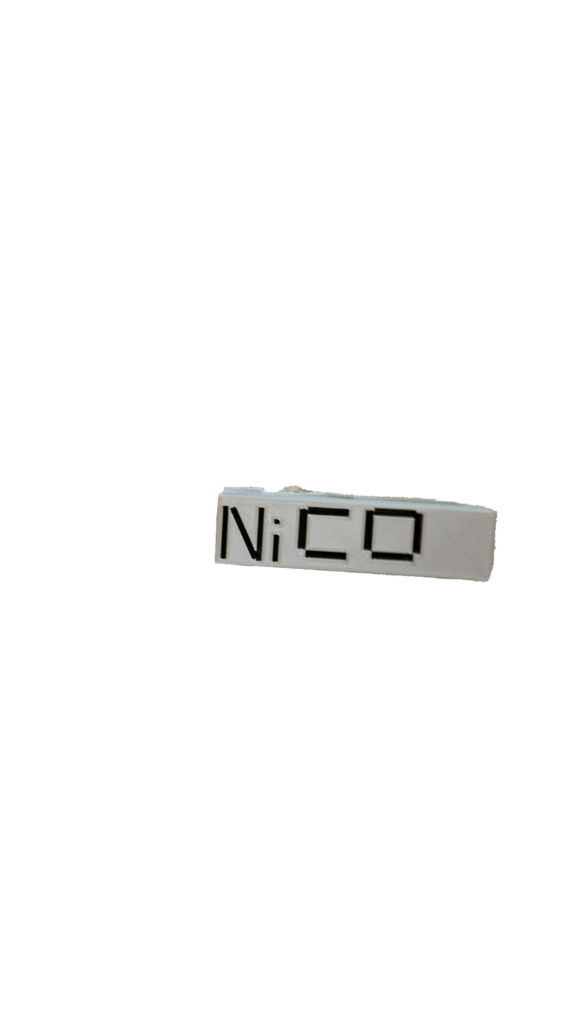
Worksheets
Worksheet 1:
Worksheet 2
Worksheet 3
Reflection
I started this project I wanted to be doing one word and two medium, so I chose my childhood nickname “Nico” and I started with TinkerCAD, then I made the other name out of Lego. So in WA 20 they learn about: Unit 2: Graphical Representations, Unit 3: Surface Area, Volume & Capacity, and Unit 5: Scale Representation. So I started with Unit 5, where they need to create a Scale factor (SF) between two mediums. Then in Unit 2, they need to collect data from their peers first hand. Then in Unit 3, they will calculate the Surface Area, and Volume of their project. This project was a bit difficult to create the graph part of the project because it required me to collect data from 10 or more people to create the graphs. Also, when I was done creating the word in the first meduim I found out it printed the C and the O as Uppercase letters when the Regina Public Library printed my project. That is what I created for my project in WA20.
Overall Reflection:
When I was using different meduims some projects took me a long time to create like “Ciarciaglini” in crocheting. Also, “Schizencephaly” took me longer to create because the words were longer and because the mediums were needing soild making to figure out the Area, Volume and Mass. Then doing a four character word was quick and easy to do, so students can be done this project quick and easy. It is a pretty easy project to create and I had fun creating these words in the meduim I chose. I decided to not to do the math behind “Schizencephaly” but that is the only one that I did not do in it.
The file of Introduction, Rationale, & Media Description:
Introduction:
This project is going to be used to create something that can be used to get to know their peers. It can be developed into different learning objectives in Workplace 10 and 20 (WA 10/20). In WA10, they learn about different topics like income, perimeter, area, volume, mass, and unit conversions. Then, in WA20 the students are introduced to surface area, volume, graphs, and scale. So, this project should reflect these concepts they learn about, and relate this to being in real-life problems.
The Making Process:
When I started with this project, I started to think about maybe I can have students create an adaptation for EFAP rooms as part of the Volunteer work as part of Catholic Studies (9/10/20/30). But I realize that there is so much research I would need to do. So, I went a very simple project that I could do with students with disabilities. I went along with the “creation of a font” idea, because it is a good way to learn about the student and see who they are and allow students to learn something new about their classmates. To see what their interest are as well, because of the freedom to choose their medium to use something they are familiar with and which are masters at using.
Discovery:
I started by researching what type of learning is with crocheting. Then, I asked my mom, “What do you think about just using crocheting as my medium to create a word?”. She responded, “Will that take lots of time to teach students how to crochet.” That is why I decided to have an open-ended medium that students can choose.
Then I only wanted to create a name (or nickname) because in one of my university classes, a professor made nametags and that was how she took attendance for who was present. Then, my mom asked, “What if the student’s name is just two letters?” I did not know how to respond to that, then I decided to do a word that have a significant meaning to the student.
Interpretation:
I wanted to do a project that crocheting is one of my mediums. However, I realized that some students do not know how to crochet and/or do not like to crochet. That is why I chose an open-ended medium.
Ideation:
I started with the word-creation idea then I developed it into the creation of a font because that is what it is. This project is about creating a word in your style and it is easier to relate to math concepts.
Experimentaion:
I started this project, my crocheting and this project was just going to be crocheting and I started to create patterns. Then I got some feedback from my mom and started to explore other mediums that I could do, and I came up with the freedom to choose the medium I chose (Tinker CAD, Minecraft, Lego, and Crocheting as mediums).
I also got feedback from my peers on how I can relate this project back to Math. I came up with two subject areas Workplace and Apprenticeship Math 10 and 20 (WA10 and WA20). In WA10, I figured out that they can do Units 2, 3, and 4, which are about spatial measurements (perimeter, area, volume, and mass), and income. Then in WA20, they will do Units 2, 3, and 5, which are about graphical representations, area and volume, and Scale representations. So, I related both mathematic subjects to the creation of words.
Evolution:
I expanded this project a lot throughout the Making process. I started with a simple idea and then developed the idea into a more complex project. I expanded the project to include people who need adaptations who do not usually understand the mathematic concepts, but still have fun creating the project.
Purpose:
The main purpose of this project is to create something personal that I can learn about the student, and their peers can learn something about one another.
Another, thing about the purpose is that the student will not have any criteria that they can do other than one thing, “It has to be School-Appropiate Word” (If they choose not school appropiate they get -2.5 marks off their final product).
Rationale
When developing this project, I came up with something called a “Math Craft”. This term allows students to reflect on real-life learning in math, crafts, and sciences (Kokko et al., 2015). I talk from experience because I learnt math from crocheting, and that is something I want to share with others so that they can do something they love to do and create something that they have experience creating. I wanted to also to show them that anything can be related to mathematics so that they can understand that in any medium, there is math behind that medium they chose. I focused more on how to make this project “ability-friendly” project. This is for people who require an adaptation to create something they can create.
Media Description & Rationale:
I chose this Math craft because it helps people with disabilities, I can relate to developing math skills relating to crafts. In an article, “83 Writing and Number Skill Development of Children with intellectual disability through Craft and Games” by Maheswari, M; and Chinnasamy, R., talk about how learning through crafts and games helps kids with intellectual disabilities (ID) can help them with writing, numbers, and reading skills (2022, p. 184). In the number skill section, the authors state that “Basic number concepts set the foundation for learning more advanced math concepts.” (Maheswari & Chinnasamy, 2022, p. 184). In the article it describes crafts as “making and doing” (2022, p. 184). Doing crafts and games in the classroom helps students with disabilities with fine motor skills, hand-eye coordination, communication, and social skills through systematic and intensive training (2022, p. 190). According to the article, the implementation of crafts in the classroom has a positive improvement for kids with ID (2022, p. 190-191). I can agree with these results because I can understand math concepts like multiplication after I saw patterns in crocheting.
In another article, it describes how arts and crafts can help students gain interest in Science, Technology, Engineering, and Mathematics (STEM). The article discusses how engineers understand the importance of arts and crafts in the STEM field (Root-Bernstein, 2015, p. 204). So, in saying the importance of with crafts is important to the interest of the STEM field. I decided to make this project open-ended so students can have the freedom to develop their understanding of concepts about mathematics and enjoy doing this project. This project is also very simple to do in the classroom, and it focuses on the student’s creativity in developing their project.
Context & Learning Objectives:
Context:
10 lv:
Students will choose one (school-appropriate) word and one medium to create with that medium. If they do not choose a word that is not school-appropriate they need to choose another word and get -2.5 points to their final mark for this project. Students will log all their hours, find the following: perimeter, area, volume, and mass; they will convert the unit measurements; and they will also figure out how much they will get paid.
20 lv:
Students will choose one (school-appropriate) word and two mediums to create with that medium. If they do not choose a word that is not school-appropriate they need to choose another word and get -2.5 points to their final mark for this project. Students will collect data, find the following: area and volume, and they will find the scale between the two mediums.
Learning Objectives:
10 lv:
WA10.1
Demonstrate understanding of the preservation of equality including solving problems that involve the manipulation and application of formulas related to:
- perimeter
- area
- the Pythagorean Theorem
- primary trigonometric ratios
- income.
WA10.3
Demonstrate using concrete, and pictorial models, and symbolic representations, understanding of measurement systems including:
- The Système International (SI)
- The British Imperial system
- The US customary system.
WA10.5
Demonstrate using concrete and pictorial models, and symbolic representations, understanding of area of 2-D shapes and surface area of 3-D objects including units in SI and Imperial systems of measurement. ([CN, ME, PS, R, T, V])
WA10.11
Demonstrate understanding of income including:
- wages
- salary
- contracts
- commissions
- piecework
- self-employment
- gross pay
- net pay.
20 lv:
WA20.3
Extend and apply understanding of surface area, volume, and capacity using concrete and pictorial models and symbolic representations (SI or imperial units of measurement).
WA20.5
Extend and apply understanding of 3-D objects including:
- top, bottom, and side views
- exploded views
- component parts
- scale diagrams.
WA20.11
Extend and apply understanding of representing data using graphs including:
- bar graphs
- histograms
- line graphs
- circle graphs.
Everything:
In this section, you can download all lesson plans, worksheets, and rubrics. For Teacher’s use ONLY.
WA 10:
WA 20:
Assessments:
WA 10:
Each individual lesson plan has a formative and summative assessment. The “formative assessment” assesses a student’s participation. The “summative assessment” assesses the student’s understanding of math concepts.
WA 20:
Each individual lesson plan has a formative and summative assessment. The “formative assessment” assesses a student’s participation. The “summative assessment” assesses the student’s understanding of math concepts.
Lesson Plans:
In this section, here are all the lesson plans that teachers should follow in order to complete this project. For Teacher’s use ONLY.
WA 10:
| Lesson Number | Lesson Plan Title | Class(es) [Total] |
| 1 | Introduction | One [1] |
| 2 | Creation | Five [6] |
| 3 | Perimeter, Area, Volume & Mass | Five [11] |
| 4 | Converting | Two to Three [11-13] |
| 5 | Pay Statement | One [12-14] |
| 6 | Presentation | One to Three [13-17] |
Zip File:
Individual Lessons:
WA 20:
| Lesson Number | Lesson Plan Title | Class(es) [Total] |
| 1 | Introduction | One [1] |
| 2 | Creation | Five [6] |
| 3 | Area& Volume | One to Two [7 – 8] |
| 4 | Collecting Data | One [8-9] |
| 5 | Presentation | One to Three [9-12] |
Zip File:
Individual Lessons:
Worksheets:
In this section, these are the worksheets that are needed for students to complete.
WA 10:
Zip File:
Separate Worksheets:
WA 20:
Zip File:
Separate Worksheets:
Rubrics:
This is how I will evaluate the student’s final product:
WA 10:
WA 20:
References:
Bottge, B. A., Heinrichs, M., Dee Mehta, Z., Rueda, E., Hung, Y., & Danneker, J. (2004). Teaching mathematical problem solving to middle school students in math, technology education, and special education classrooms. RMLE Online, 27(1), 1-17.
Kokko, S., Eronen, L., & Sormunen, K. (2015a). Crafting maths: Exploring mathematics learning through crafts. Design and Technology Education: An International Journal, 20(2), 22-31.
Kokko, S., Eronen, L., & Sormunen, K. (2015b). Crafting maths: Exploring mathematics learning through crafts. Design and Technology Education: An International Journal, 20(2), 22-31.
Maheswari, M., & Chinnasamy, R. (2022). 83 Writing and number skill development of children with intellectual disability through craft and games. Journal of Education, 23, 183-191.
McLeod, J. C., Wilson, P. L., Pomeroy, D., & Brogt, E. (2019). Maths Craft in Class. Paper presented at the Bridges 2019 Conference Proceedings, 469-472.
Root-Bernstein, R. (2015). Arts and crafts as adjuncts to STEM education to foster creativity in gifted and talented students. Springer Science and Business Media LLC. https://10.1007/s12564-015-9362-0
Additional Resources
Mass in Mincraft Chart:
| Type | Size | Mass |
| Concrete | Per cubic meter (1 m³) | 2,600 Kg |
| TBD | TBD | TBD |
Microsoft Word & Google Docs Tutorials:
In this section, I put in tutorials about how students can use Microsoft Word & Google Docs to type up their Minecraft Plans. What is in this section:
- How to create shapes: In this section, is for students to show them, how to create shapes: lines, circles, triangles, squares, & cubes.
- How to insert equations: In this section, is for students to show them, how to use equations: how to start an equation, how to insert symbols (like parallel lines (∥), and theta(ϑ)) & operators (like times (“*” or “✕”) and division (like “/” or “÷”).
- How to convert Microsoft Word to Google Docs: In this section shows the students & teachers how to convert a Word document into a Doc document.
















